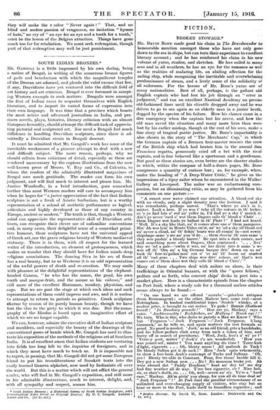SOUTH INDIAN BRONZES.*
Ma. GA1TGOLI is a little impressed by his own daring, being a native of Bengal, in writing of the numerous bronze figures of gods and benefactors with which the magnificent temples of the Deccan are adorned, and pleads the valid excuse that few, if any, Dravidians have yet ventured into the difficult field of art history and art criticism. Bengal is ever foremost in accept- ing Western example in such matters. Bengalis were amongst the first of Indian races to acquaint themselves with English literature, and to import its varied forms of expression into their own language. It was time that a province which boasts the most active and advanced journalism in India, and pro- duces novels, plays, histories, literary criticism with an almost European fecundity, should attempt the difficult task of apprecia- ting pictorial and sculptured art. Nor need a Bengali feel much diffidence in handling Dravidian sculpture, since there is ad- mittedly a Dravidian strain in Bengali descent.
It must be admitted that Mr. Gangoli's work has some of the inevitable weaknesses of a pioneer attempt to deal with a new and difficult subject. The more reason, perhaps, why we should refrain from criticisms of detail, especially as these are rendered unnecessary by the copious illustrations from the now well-known press of Messrs. V. Ray and Co., of Calcutta, to whom the readers of the admirably illustrated magazines of Bengal owe much gratitude. The reader can form his own judgment, and will find much to interest and please him. Mr. Justice Woodroffe, in a brief introduction, goes somewhat further than most Western readers will care to accompany him when he hopes for "a juster appreciation of the fact that Indian sculpture is not a freak of Asiatic barbarism, but is a worthy representation of a school of aesthetic performance as logical, articulate and highly developed as those of any country in Europe, ancient or modern." The truth is that, though a Western mind can appreciate the representative skill of Dravidian arti- ficers, can recognize their clever use of unfamiliar conventions and, in many cases, their delightful sense of a somewhat primi- tive humour, these sculptures have not the universal appeal of Greek art, nor the grave religious beauty of Western mediaeval statuary. There is in them, with all respect for the learned writer of the introduction, an element of grotesqueness, which makes us wonder that they should have for Indian minds deep religious associations. The dancing Siva in his arc of flame has a real beauty, but to us Westerns it is an odd representation of the awful powers of death and re-creation. We may smile with pleasure at the delightful representations of the elephant- headed Ganesa, "he who has the noose, the goad, his own tooth and mangoe-fruit, and the mouse as his wham," and still more of the excellent Hanuman, monkey, physician, and sage. But we are past the stage at which such ideas and such representations of them could impress and awe, and it is useless to attempt to return to periods so primitive. Greek sculpture charms by reason of its purely human beauty, though we have lost the clue to the piety to which it was due. But the icono- graphy of the Hindus is based upon an imaginative effort of which we are no longer capable.
We can, however, admire the executive skill of Indian sculptors and moulders, and especially the beauty of the drawings of the conventional poses of hands which Mr. Gangoli has used to illus- trate his exposition of the methods of the religious art of Southern India. It is of excellent omen that Indian students are venturing into fields too long left to the inquiries of foreigners, and in which they must have much to teach us. It is impossible not to regret, in passing, that Mr. Gangoli did not get some European friend to put his transliterations of Sanskrit texts into the easily learned Geneva alphabet, now used by Indianists all over the world. But this is a matter which will not afflict the general reader, who will find in Mr. Gangoli's exposition, and still more in his admirable illustrations, much to interest, delight, and, with all sympathy and respect, amuse him.
• South Indian Bronzes : a Bistorioat Survey of South Indian Sculpture, with Iconographical Notes Bawd on Origifild Sources. By 0. C. Gangoli. London : Luxac and Co. (51 Is. nct.I


































 Previous page
Previous page